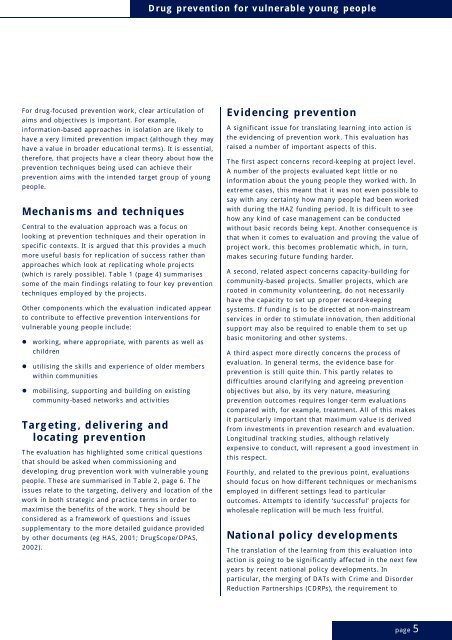Drug prevention for vulnerable young people - Nacro
Drug prevention for vulnerable young people - Nacro
Drug prevention for vulnerable young people - Nacro
You also want an ePaper? Increase the reach of your titles
YUMPU automatically turns print PDFs into web optimized ePapers that Google loves.
<strong>Drug</strong> <strong>prevention</strong> <strong>for</strong> <strong>vulnerable</strong> <strong>young</strong> <strong>people</strong>For drug-focused <strong>prevention</strong> work, clear articulation ofaims and objectives is important. For example,in<strong>for</strong>mation-based approaches in isolation are likely tohave a very limited <strong>prevention</strong> impact (although they mayhave a value in broader educational terms). It is essential,there<strong>for</strong>e, that projects have a clear theory about how the<strong>prevention</strong> techniques being used can achieve their<strong>prevention</strong> aims with the intended target group of <strong>young</strong><strong>people</strong>.Mechanisms and techniquesCentral to the evaluation approach was a focus onlooking at <strong>prevention</strong> techniques and their operation inspecific contexts. It is argued that this provides a muchmore useful basis <strong>for</strong> replication of success rather thanapproaches which look at replicating whole projects(which is rarely possible). Table 1 (page 4) summarisessome of the main findings relating to four key <strong>prevention</strong>techniques employed by the projects.Other components which the evaluation indicated appearto contribute to effective <strong>prevention</strong> interventions <strong>for</strong><strong>vulnerable</strong> <strong>young</strong> <strong>people</strong> include:• working, where appropriate, with parents as well aschildren• utilising the skills and experience of older memberswithin communities• mobilising, supporting and building on existingcommunity-based networks and activitiesTargeting, delivering andlocating <strong>prevention</strong>The evaluation has highlighted some critical questionsthat should be asked when commissioning anddeveloping drug <strong>prevention</strong> work with <strong>vulnerable</strong> <strong>young</strong><strong>people</strong>. These are summarised in Table 2, page 6. Theissues relate to the targeting, delivery and location of thework in both strategic and practice terms in order tomaximise the benefits of the work. They should beconsidered as a framework of questions and issuessupplementary to the more detailed guidance providedby other documents (eg HAS, 2001; <strong>Drug</strong>Scope/DPAS,2002).Evidencing <strong>prevention</strong>A significant issue <strong>for</strong> translating learning into action isthe evidencing of <strong>prevention</strong> work. This evaluation hasraised a number of important aspects of this.The first aspect concerns record-keeping at project level.A number of the projects evaluated kept little or noin<strong>for</strong>mation about the <strong>young</strong> <strong>people</strong> they worked with. Inextreme cases, this meant that it was not even possible tosay with any certainty how many <strong>people</strong> had been workedwith during the HAZ funding period. It is difficult to seehow any kind of case management can be conductedwithout basic records being kept. Another consequence isthat when it comes to evaluation and proving the value ofproject work, this becomes problematic which, in turn,makes securing future funding harder.A second, related aspect concerns capacity-building <strong>for</strong>community-based projects. Smaller projects, which arerooted in community volunteering, do not necessarilyhave the capacity to set up proper record-keepingsystems. If funding is to be directed at non-mainstreamservices in order to stimulate innovation, then additionalsupport may also be required to enable them to set upbasic monitoring and other systems.A third aspect more directly concerns the process ofevaluation. In general terms, the evidence base <strong>for</strong><strong>prevention</strong> is still quite thin. This partly relates todifficulties around clarifying and agreeing <strong>prevention</strong>objectives but also, by its very nature, measuring<strong>prevention</strong> outcomes requires longer-term evaluationscompared with, <strong>for</strong> example, treatment. All of this makesit particularly important that maximum value is derivedfrom investments in <strong>prevention</strong> research and evaluation.Longitudinal tracking studies, although relativelyexpensive to conduct, will represent a good investment inthis respect.Fourthly, and related to the previous point, evaluationsshould focus on how different techniques or mechanismsemployed in different settings lead to particularoutcomes. Attempts to identify ‘successful’ projects <strong>for</strong>wholesale replication will be much less fruitful.National policy developmentsThe translation of the learning from this evaluation intoaction is going to be significantly affected in the next fewyears by recent national policy developments. Inparticular, the merging of DATs with Crime and DisorderReduction Partnerships (CDRPs), the requirement topage 5
















